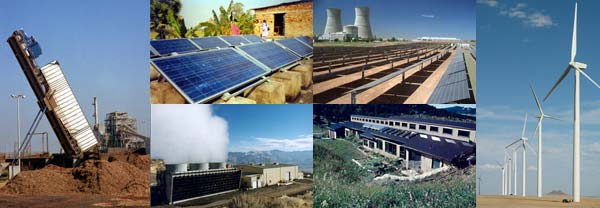Alternatives to Fossil Fuels
Ever-increasing worldwide use of oil, gas, and coal—fossil fuel—leads to more carbon dioxide (CO2) emissions, which in turn causes global warming. In addition, fossil fuel is a limited resource. The next step: to develop the other energy sources, ones that produce little or no CO2 emissions.
|
Some examples of alternative energy sources (clockwise from left): biomass, solar, nuclear, wind, passive heating & cooling, geothermal. |
Many alternative sources are already widely used. Hydroelectric and nuclear energy plants generate a significant portion of the world’s power. Other sources, including solar energy, wind power, and biomass fuel provide a small share of a region’s power but could provide much more. Sources such as tidal power and geothermal heat are site-specific, and of use only in the right location. Some promising technologies, for example the hydrogen fuel cell, remain under development.
One key advantage of water, sunlight, wind, or plants: They are everywhere, in essentially unlimited quantities. We need to find the best way to use these resources to their fullest.
We all agree that in the long run the world needs to find alternatives to oil, gas, and coal—the fossil fuels. Fossil fuels generate CO2, which adds to global warming. The power sources that replace fossil fuels must be cleaner, and not add to pollution or climate change. As an added bonus these fuels should be substances that are easily located—and ideally, renewable energy sources. But what?
The answer lies with the environment around us: sunlight, wind, water, plants, and heat from the Earth. Some of these sources are as old as can be. Wood has been burned for heating and cooking since humans first learned to make fire. Windmills helped irrigate the fields of ancient Persians. The ancient Greeks and Romans used falling water to turn waterwheels. But by the early 20th century, cheaper fossil fuels all but replaced these traditional sources in many places as the provider of power.
Unlike that from fossil fuels, energy from sunlight, wind, water, plants, and geothermal heat does not create extra carbon dioxide, and so does not add to global warming. Best of all, unlike fossil fuels, which will become increasingly scarce, these fuel sources are renewable and will never run out. One day, they may completely replace fossil fuels.
Let’s take a look at how the alternatives to fossil fuels are being used, right now…
This content has been re-published with permission from SEED. Copyright © 2025 Schlumberger Excellence in Education Development (SEED), Inc.


